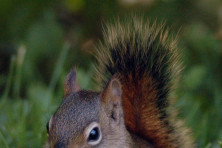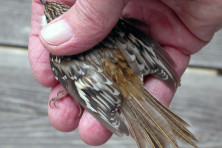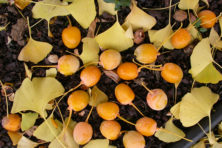Roy Lukes: Winter Tree Silhouettes
- Share
- Tweet
- Pin
- Share
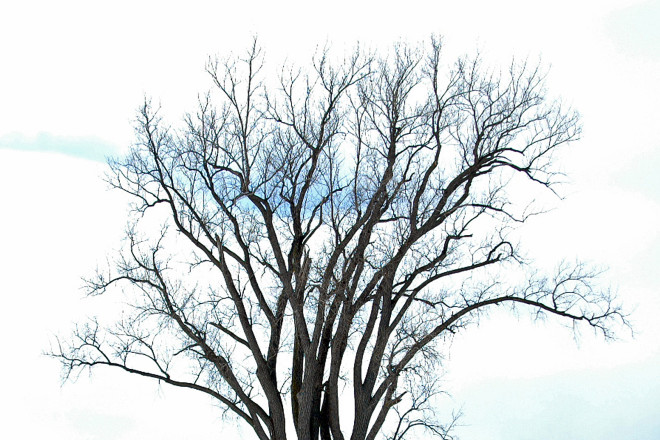
Slowly, bit by bit, amber droplet by amber droplet of fragrant sticky sap, the bouquets of balsam poplar twigs are coming to life, adding wild perfume to our home. Within a week or two their light green leaves will be unfurling and it is then that the balmy aroma will have reached its highest peak of perfection. We shall have a two-month jump on the heady spring essence of the great outdoors.
Unless a person is in the woods making firewood for next fall, deciduous trees receive little attention from most people. They are leafless for about six months of each year yet their artistic winter anatomy captures hardly a passing glance.
Really, it is now that their true beauty and bare bones character, not masked by thick concealing canopies of green, are revealed. Their overall majestic shape, main axis, branching patterns, twigs, buds and other interesting characteristics come to life.
I wouldn’t think of walking through a nearby woodland without making a special detour to admire two small groves of American hornbeam, or blue beech trees. Due to the undulating, rippling nature of the small, smooth-barked tree, it has been nicknamed the “muscle tree.” Unconsciously I caress a trunk as though I’m shaking hands with brother hornbeam and silently wishing it well.
March is a good month to photograph tree silhouettes and to admire the subtle changing colors of some trees’ trunks and branches. With stubborn winter slow to give in to fickle spring it is common to have snow plastering the stormward sides of trunks in early morning only to begin melting by noon. The wetted trunks now glisten with totally different colors and appearance until they dry back to their natural conditions.
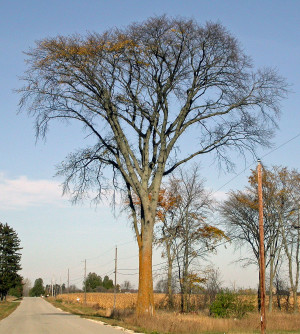
A distinctive tree shape is found in the American elm, with its tall straight trunk and high spreading branches like a giant vase of flowers. Photo by Roy Lukes.
Door County’s highways and back roads have isolated hardwood trees that show their great size and character. Some of the tallest are the eastern cottonwoods and a few American elms that have resisted the Dutch elm disease that devastated so many of their kind in cities across the country.
Give most people an outline drawing of a tree, a box of crayons and tell them to color the tree, the majority will reach for the brown crayon to do the trunk.
Would you like to partake of an interesting exercise? Take a box of crayons, paints or a color chart along on your next hike into the woods and try to match your colors with the tree trunks. Surely there will be dark gray, blackish, whitish gray, reddish gray, etc. but seldom brown trunks to match your brown crayon.
Think of the last red pine you’ve seen or perhaps a huge sycamore tree that you admired on a recent trip southward. Describe in writing the colors and patterns of the trunks. What magnificent objects they are even during their dormancy. My guess is that the druids of ancient history became tree worshipers during the winter months when trees revealed their most beautiful and intriguing individuality.
Another feature about trees that most people don’t think about is that they are flowering plants. Granted their exquisitely tiny flowers don’t resemble tulips or roses, but nevertheless each species of tree flower has its own singular shape and beauty.
A classic book to help in your study and appreciation of this seldom noticed annual phenomenon is Tree Flowers of Forest, Park and Street by Walter E. Rogers. He was, for many years, a professor of botany at Lawrence University in Appleton, Wis. His greatly enlarged photographs are spectacular, as are the numerous small drawings and winter silhouettes done by Olga A. Smith, then an instructor of botany at Lawrence University. The book has been reprinted by Dover Press.
One can go on and on listing the attributes of trees, including that of providing us with shelter, beautification of property, wildlife food and habitat, shade and distinctiveness for our streets and highways, and life and character to our landscape.
In addition to the thousands of products of the forest contributing to our day-to-day life, so do living trees bring beauty, relaxation and enjoyment into our lives during all seasons of the year.
Most people, including myself, look at trees as the oldest, largest and most massive living things on our planet. Take the bristlecone pine for example. These gnarled, stunted, deformed trees growing in harsh dry climates at high elevations in some western states began their growth before the building of the Great Pyramids in Egypt.
Do you suppose these same magnificent old monarchs may still be alive when true harmony and total peace will prevail among people and with nature throughout the world?

